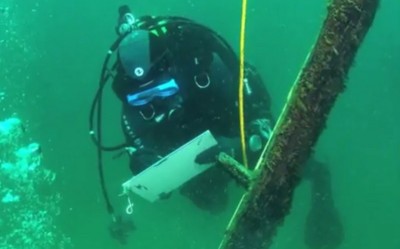
Artifacts, such as this wood plank found at the bottom of Lake Michigan, could belong to the Griffin, a vessel that sunk in the area in 1679.
Steve Libert, who has been scouring the Great Lakes for years looking for the wreckage of the long-lost Griffin, may have finally found it.
According to a report released by The Associated Press, Libert is “99.9 percent sure” the debris found by his crew on the bottom of Lake Michigan earlier this month belongs to the ancient vessel. Though the Great Lakes Exploration divers have not yet found any guns, cannons, or other artifacts with the Griffin name or emblem on them, an area the size of a football field is strewn with debris that may lead to more cohesive conclusions.
Libert’s fascination with the Griffin began at a young age, when his eighth-grade history teacher described the ship’s mysterious disappearance on its maiden voyage in 1679. French explorer and the ship’s architect, Robert de La Salle, had disembarked the boat near Green Bay, Wisconsin before its disappearance. The six others who remained on the ship were never found. According to historians, the Griffin was not only the first European ship to sail the Great Lakes, but also the first to sink there.
After dedicating 35 years to the project, Libert said the first big break came in 2001 when divers found a plank of wood protruding from the lake’s bottom. Libert believes the wood, along with others found near it, originally comprised the Griffin’s bow. His team was finally given permission to excavate the artifact last year and have been running extensive tests to confirm its age. “If it’s 300 years old, there’s only one ship it could be,” Libert told the New York Daily News.
Other researchers and archaeologists are a bit more skeptical.
Michel L’Hour, director of the Department of Underwater Archaeological Research in the French Ministry of Culture and an authority on shipwrecks, acknowledged that though the findings were encouraging, much more evidence is needed to determine if this site is truly the resting place of the Griffin. For example, artifacts, including fasteners similar to those used on La Belle, another ship built by La Salle, could also easily be from the 19th century. L’Hour did express interest in collaborating to explore further, however.
Michigan archaeologist Dean Anderson also questioned the claims, supporting the theory that the previously-found wooden slab is in fact debris from a fishing boat. “That piece of wood certainly bears a very striking resemblance to a net stake,” Anderson told Fox News. “In my opinion, I haven’t seen any evidence that suggests that anyone has found wreckage of the Griffin there.”
But Libert and his team are still hopeful. They are currently seeking federal and state permits to explore the site more thoroughly, and hope to be able to excavate the area by September of this year.
View the video below for the official news release:
Image and video courtesy of Newsloop/YouTube
 Your Privacy Choices
Your Privacy Choices
 The
The